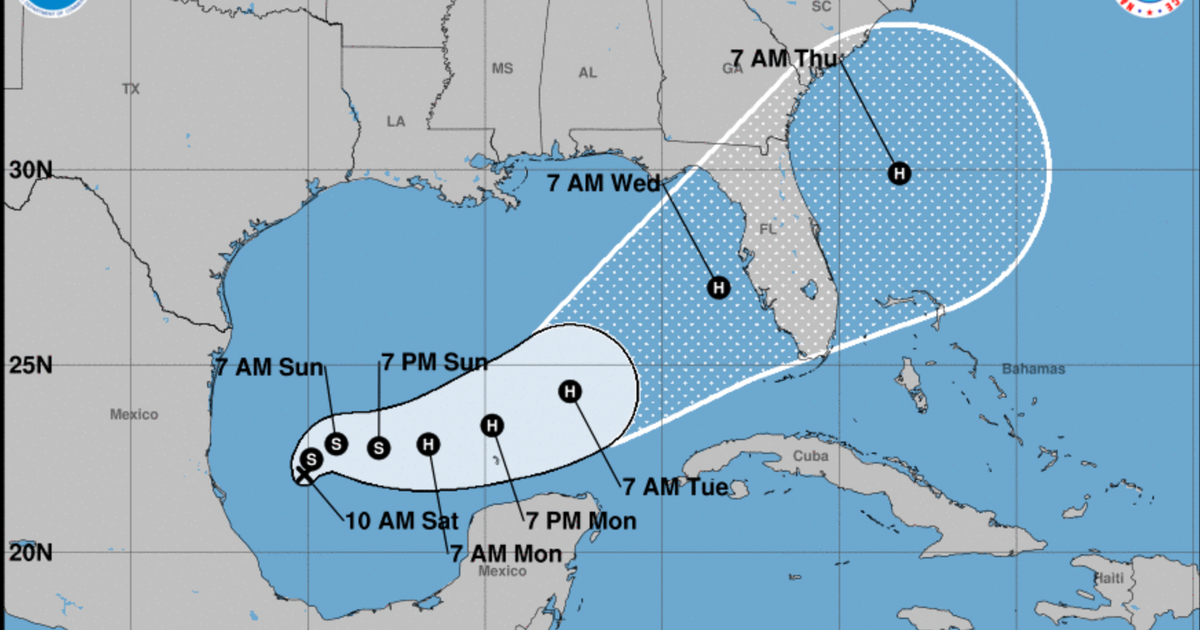CBS News
Rare case of plague is confirmed in Oregon. Here’s what to know about symptoms and how it spreads.

Health officials in Deschutes County, Oregon, confirmed a rare case of human plague in a local resident last week, marking the first reported case in the state since 2015. Officials said the individual was likely infected by their pet cat, which showed symptoms of the disease.
“All close contacts of the resident and their pet have been contacted and provided medication to prevent illness,” Deschutes County Health Officer Dr. Richard Fawcett said in a news release Wednesday.
No additional plague cases have emerged during their investigation, said officials in the mostly rural county in central Oregon.
“Fortunately, this case was identified and treated in the earlier stages of the disease, posing little risk to the community,” the release states.
Though bubonic plague may sound like something out of the history books, this isn’t the first time in recent years we’ve seen the disease pop up in the U.S.
In 2020, California reported its first case of plague in five years. Officials said at the time that the patient, a resident of the South Lake Tahoe area, was recovering at home. Two fatal cases were reported in Colorado in 2015.
While reports of the plague can be scary, and the disease can be serious, experts say there’s little cause for concern for most people. Here’s what to know:
What is the plague?
Plague is a disease caused by Yersinia pestis, a bacterium found in rodents and their fleas.
In the Middle Ages, the plague caused tens of millions of deaths across Europe in a series of outbreaks known as the Black Death. While the bacterial infection is still around today, it is far more rare in modern times and it can be treated.
There are three types of plague: septicemic, pneumonic and bubonic, which is the most common form, accounting for around 80% of cases in this country. (More on each type below.)
The Centers for Disease Control and Prevention says 496 cases of plague were documented in the U.S. between 1970 and 2020, with almost all occurring in the West or Southwest. More than half of the cases were reported in New Mexico, followed by smaller numbers in Colorado, Arizona, California and Oregon.
How is the plague transmitted to humans?
People typically get the plague after being bitten by an inflected flea or handling an infected animal, according to the CDC.
Many types of animals can be affected by plague, including:
- Squirrels
- Mice and rats
- Prairie dogs
- Chipmunks
- Voles
- Rabbits
“Wild carnivores can become infected by eating other infected animals,” the CDC notes.
Cats and dogs can also lead to human infections. Cats are particularly susceptible to getting sick, and have been linked to several cases of human plague in the U.S. via respiratory droplets in recent decades.
Health officials say symptoms of plague usually start to appear two to eight days after a person was exposed to an infected animal or flea.
In some cases, pneumonic plague can spread when an infected person coughs, causing infectious droplets to spread. This is the only type of plague that can be transmitted between people.
What are the symptoms of plague?
Symptoms depend on what type of plague someone is infected with.
Bubonic plague: A key symptom is painful, swollen lymph nodes in the groin or armpits, called buboes. Other common symptoms include fever, weakness, coughing and chills. The majority of cases seen in the U.S. are this type.
Septicemic plague: Septicemic plague occurs when the bacteria gets into the bloodstream. Patients may develop fever, chills, extreme weakness, adnominal pain, shock and possibly internal bleeding. Skin and other tissues, especially on fingers, toes, and the nose may turn black and die. The CDC explains that an infection may start out as septicemic plague or it can develop if a case of bubonic plague goes untreated.
Pneumonic plague: Untreated bubonic or septicemic plague can develop in the pneumonic plague, which spreads to the lungs. These patients may develop fever, headache, weakness, pneumonia, shortness of breath, chest pain, cough and sometimes bloody or watery mucous. Pneumonia could cause respiratory failure and shock. This type of plague is considered the most serious form of the disease, with a high fatality rate.
Is there a treatment for plague?
Plague can be successfully treated with antibiotics, the CDC says, but the earlier the better to improve chances of a full recovery.
“To prevent a high risk of death in patients with pneumonic plague, antibiotics should be given as soon as possible, preferably within 24 hours of the first symptoms,” the CDC says.
The bubonic type has a case-fatality ratio of 30% to 60%, according to the World Health Organization.
Pneumonic plague, when left untreated, is always fatal and death can occur within 18 to 24 hours.
“The key for clinicians is suspecting plague in the first place, obtaining the right specimens to make a diagnosis, and initiating treatment even before the diagnosis is made — as soon as you suspect it, you should start treating while the evaluation is ongoing,” Dr. Erica S. Shenoy, chief of infection control at Mass General Brigham healthcare system, previously told CBS News.
How to prevent getting plague
How do you keep your pets from exposing you to the plague? To protect yourself, protect them.
“It’s important to keep fleas off your pets because fleas can transmit not only the plague but also other infections,” says Dr. Céline Gounder, a CBS News medical contributor and editor-at-large for public health at KFF Health News.
You can do this by applying flea control products, the CDC recommends.
“Letting your pets roam freely, particularly in parts of the western U.S. where plague is endemic, also increases their and your risk of exposure,” Gounder says, adding that it goes beyond just preventing fleas. “Cats can also get the plague by eating infected rodents and can transmit the plague to people through the air, too.”
The CDC recommends not allowing dogs or cats that roam outdoors in affected areas to sleep in your bed.
Other steps you can take to protect yourself and your family include:
- Reducing rodent habitats around your home, workplace and other areas.
- Using insect repellent if you may be exposed to rodent fleas during activities like hiking or working outdoors.
- Wearing gloves whenever handling potentially infected animals.
-Sophie Lewis contributed to this report.
CBS News
Tropical Storm Milton forms in Gulf; forecast to strengthen into hurricane headed toward Florida

Tropical Storm Milton has formed in the Gulf of Mexico and is forecast to strengthen into a hurricane headed toward Florida with possible impacts to its western coast, the National Hurricane Center said on Saturday. Maximum sustained winds are expected to be at 40 mph with higher gusts and Milton is currently moving north-northeast, NHC said in an advisory.
Milton is forecast to undergo a period of rapid intensification before it makes landfall as a Category 2 hurricane across Florida’s west coast, CBS News Miami reported.
The forecast comes a little more than a week after Hurricane Helene made landfall in Florida and across the Southeast, killing more than 200 people and causing immense destruction. President Biden on Thursday took an aerial tour of Florida’s Big Bend where Helene struck as a Category 4 storm. Hundreds of people are still missing and Mr. Biden said the work to rebuild will cost “billions of dollars” as communities suffer still without power, running water and passable roads.
NOAA
Milton is forecast to move across the southwestern Gulf of Mexico through Sunday night then across the south-central Gulf on Monday and Tuesday before reaching Florida’s west coast by the middle of the week, NHC said. Heavy rain is possible in the region starting Sunday into Monday, CBS Miami reported, and more rain and heavy winds will most likely arrive on Wednesday. Hurricane and storm surge watches will most likely be required for portions of Florida starting Sunday, the National Hurricane Center said.
Along with the heavy rainfall, the hurricane center said to expect risks of flooding.
Residents in the area should ensure they have a hurricane plan in place, the National Hurricane Center said, follow the advice of local officials and check back for forecast updates.
CBS News
10/5: Saturday Morning – CBS News

Watch CBS News
Be the first to know
Get browser notifications for breaking news, live events, and exclusive reporting.
CBS News
Barbie announces first “Diwali doll” ahead of festival of lights

A new Barbie has joined Mattel’s lineup of inclusive dolls. The first “Diwali doll” was announced by the toymaker on Friday, a few weeks shy of the Hindu holiday of Diwali, also known as the festival of lights.
The festival, which lasts for five days, is marked on Western calendars to begin on Nov. 1, but some celebrations start on Oct. 31.
The doll, created in collaboration with fashion designer Anita Dongre, features traditional elements including the lehenga skirt, floral print and golden shoes, according to Mattel’s website. The doll is available at major retailers for $40.
“The look is infused with beauty and symbolism to rejoice in victory of light over darkness with contemporary silhouettes,” the description reads for the Diwali doll.
Lalit Agarwal, country manager for Mattel India, said in a news release that through the Diwali doll, the brand is hoping to showcase “India’s vibrant cultural heritage on a global stage while continuing to celebrate the power and beauty of diversity.”
Earlier this year, Mattel announced the first-ever blind Barbie doll and a Black Barbie with Down syndrome.
In addition, to celebrate International Women’s Day on March 8 and Barbie’s 65th birthday on March 9, the doll brand announced it was adding new dolls to its Role Models collection, based on real-life singers and actresses from around the world. They’re not for sale – a one-of-a-kind doll was made for each of the honored women.
The dolls are meant to introduce “girls to remarkable women’s stories to show them you can be anything,” according to Mattel.




